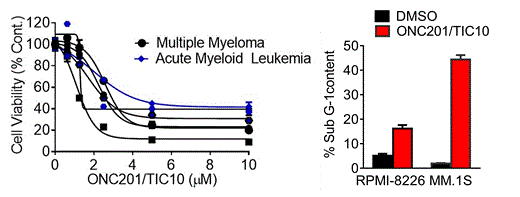Abstract
PI3K/Akt and Ras/MAPK pathways are attractive therapeutic targets in almost all tumor types, including AML and MM. Apo2L/TRAIL has been deemed a promising therapeutic given its selectivity towards cancer cells although its clinical development has been hampered by various limitations including short half-life and general shortcoming of protein-based therapeutics. ONC201/TIC10 (Oncoceutics, Inc.) is a first-in-class small molecule inducer of TRAIL expression. ONC201/TIC10 has previously been shown to up-regulate TRAIL and its death inducing receptor DR5 in HCT116 colon cancer cells, in part through the inhibition of Foxo3a phosphorylation mediated by dual inhibition of Akt and ERK (Allen JE et al, Sci Transl Med., 2013). Currently, ONC201/TIC10 is set to enter clinical trials for patients with advanced malignancies after the IND was approved by the FDA in March, 2014. We thus investigated the therapeutic potential of ONC201/TIC10 in AML and MM given a major unmet need when conventional therapy fails. We explored the possibility that ONC201/TIC10 induces apoptosis in MM and AML in part through dual inhibition of the PI3K/Akt and Ras/MAPK pathways.
We tested a panel of four human MM cell lines (KMS18, MM.1S, MM.1S 33X and RPMI-8226) and three human AML cell lines (Kasumi-1, HL60, HL60/VCR). The Cell-titer Glo assay demonstrated a time and dose-dependent decrease in viability in the entire panel of MM and AML cells. EC50 values ranged from 1-2.5 µM for the MM and 2-5µM for the AML cell lines, respectively. Bortezomib-resistant cells MM.1S 33X and vincristine- resistant cells HL60/VCR were also significantly sensitive to ONC201/ TIC10 as a single agent with EC50s on par with the corresponding parental cell lines. Given the previously reported pro-apoptotic effects of ONC201/TIC10 against solid tumor cells, we assessed apoptosis by performing Sub-G1 analyses and assessing caspase-3 cleavage as two widely used methods to analyze apoptotic cell death. We observed an average of 10-fold induction of ONC201/TIC10–mediated apoptosis in MM cells at 5 mM at 48 hrs post-treatment. Rescue of ONC201/TIC10-mediated apoptosis was demonstrated using the pan-caspase inhibitor (Z-VAD-FMK). In addition, western blot analysis in MM cells indicated a dose-dependent decrease in the anti-apoptotic protein XIAP which is a key mediator of apoptosis inhibition and is reported to be highly up-regulated in MM cells. Dose and time dependent induction of apoptosis was noted in western blot analysis of caspase-3 cleavage in AML cell lines treated with 2.5 µM or 5 µM of ONC201/TIC10 for 48 hrs prior to analysis. Western Blot analysis further demonstrated inhibition of Akt and Foxo3a phosphorylation in Kasumi-1 cells, in line with the previously proposed mechanism of ONC201/TIC10 against solid tumor cells. To further investigate the therapeutic potential of ONC201/TIC10 in the context of AML, fresh AML cells were treated with ONC201/TIC10. The primary cells were also found to be sensitive to ONC201/TIC10 (60% decrease in cell viability 72 hrs post 5mM ONC201/TIC10 treatment). Similarly, caspase 3/7 activity was significantly increased as assessed by the Caspase Glo 3/7 assay (~5 fold induction in activity 72 hrs post 5mM ONC201/TIC10 treatment). To explore further the therapeutic potential of ONC201/TIC10, we performed combinatorial experiments with bortezomib and vincristine using the MM.1S 33X MM cells and the HL60/VCR AML cell lines. ONC201/ TIC10 showed an additive effect with both these compounds against the MM and AML lines.
Our work demonstrates activity of ONC201/TIC10 against AML and MM cell lines including fresh AML tumor cells. The efficacy data with resistant cells is in par with the applicability of TIC10 in patients with refractory/relapsed hematological malignancies. The long-term goal of this project is to provide a rationale for a phase 1b trial of ONC201/TIC10 for refractory/relapsed MM and AML in combination with existing therapies.
Efficacy of ONC201/TIC10 in AML and MM cells
Allen:Oncoceutics, Inc.: Employment, Equity Ownership, Patents & Royalties. El-Deiry:Oncoceutics, Inc.: Equity Ownership, Patents & Royalties.
Author notes
Asterisk with author names denotes non-ASH members.


